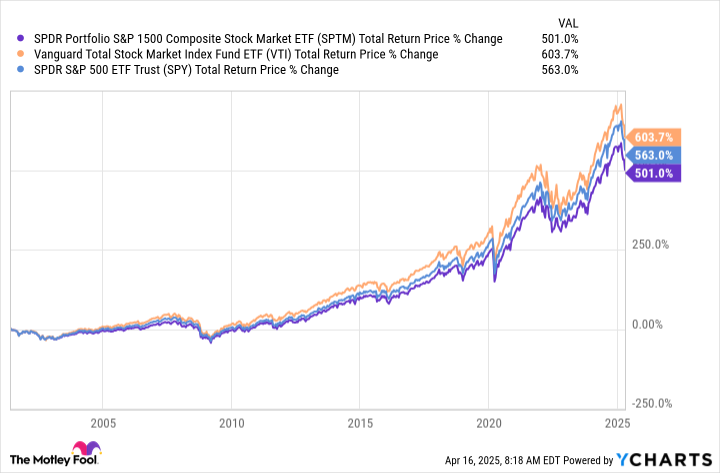Better Buy: Vanguard Total Stock Market ETF vs. SPDR Portfolio S&P 1500 ETF
-
The Vanguard Total Stock Market ETF buys the entire market.
-
The SPDR Portfolio S&P 1500 ETF buys almost the entire market, with a little human intervention along the way.
-
There is a clear winner when it comes to buying the market.
When most investors think about buying "the market," they probably have the S&P 500 index (^GSPC 0.74%) in mind. But that's not the market -- it's just 500 or so hand-selected large and economically representative companies. If you want to own the market, you'll have to consider an exchange-traded fund (ETF) like the Vanguard Total Stock Market ETF (VTI 0.65%) or the SPDR Portfolio S&P 1500 ETF (SPTM 0.66%). They are not interchangeable, and in the end, one may be even better than the S&P 500 index.
The best way to buy "the market"
It would be virtually impossible for most investors to go out and buy 500 stocks, let alone 1,500 or 3,598 (more on this strangely precise number in a second). So the only real option for buying the market is to buy a pooled investment vehicle like a mutual fund or an ETF. Given the many benefits of exchange-traded funds, including ultra-low costs and all-day trading, ETFs are likely to be the go-to option.

Image source: Getty Images.
But when you are looking to buy "the market," you have to actually decide what that means. The S&P 500 index is a good starting point, but it is a list of roughly 500 companies that have been selected by a committee to be representative of the U.S. economy. The stocks in this index, which can be bought via the Vanguard S&P 500 ETF (VOO 0.75%), make up around 80% of the market cap of all U.S. stocks. That's a lot of the market, but it isn't all of the market.
The rest of the market is largely made up of small and medium-sized companies. However, there will also be large companies that didn't make it past the committee process for some reason, which often includes financial troubles of some sort. But all of these companies add diversification for investors who truly want to own "the market." This is where the Vanguard Total Stock Market ETF and the SPDR Portfolio S&P 1500 ETF come in.
Extending the theme and just buying it all
The SPDR Portfolio S&P 1500 ETF is basically a cousin to the S&P 500 index. It owns the S&P 500, plus the S&P MidCap 400 Index and the S&P SmallCap 600 Index. Add it all up, and you get roughly 1,500 stocks that account for around 90% of the market cap of all U.S. stocks. All three of these indexes follow the same basic committee approach, though the S&P 500 gets the most scrutiny.
Still, that's not all of the market. The Vanguard Total Stock Market ETF gets you much closer, with 3,598 holdings. That said, there's no screening process here other than the stock being traded on a U.S. exchange. Like the S&P options, the Vanguard Total Stock Market ETF is market cap weighted, so the largest stocks have the most effect on the ETF's performance. However, adding in those extra 2,000 or stocks has made a big difference on the performance front.

SPTM Total Return Price data by YCharts.
As the total return chart above highlights, the Vanguard Total Stock Market ETF has outperformed both the S&P 500 index and the S&P 1500 index over the longer term. In other words, when you buy the market, all of those extra stocks -- around 20% of the overall market cap of the U.S. market -- appear to add value. Notably, cherry-picking stocks with a committee doesn't appear to help all that much.
If you want "the market," think bigger
If you say you own the market and you only own the S&P 500 index, you don't actually own the market. If history is any guide, owning as much of the market as possible appears to have a performance benefit. That's why index investors should probably take a closer look at the Vanguard Total Stock Market ETF. You may decide to stick with the S&P 500 and its committee approach, but you should at least look at your other, and possibly more attractive, options.
免責聲明:投資有風險,本文並非投資建議,以上內容不應被視為任何金融產品的購買或出售要約、建議或邀請,作者或其他用戶的任何相關討論、評論或帖子也不應被視為此類內容。本文僅供一般參考,不考慮您的個人投資目標、財務狀況或需求。TTM對信息的準確性和完整性不承擔任何責任或保證,投資者應自行研究並在投資前尋求專業建議。
熱議股票
- 1
- 2
- 3
- 4
- 5
- 6
- 7
- 8
- 9
- 10